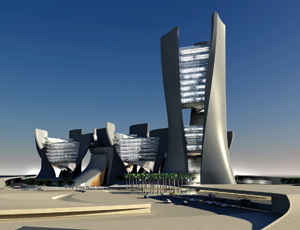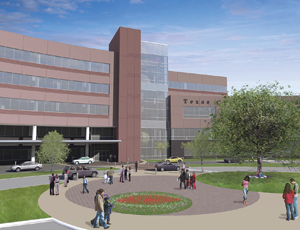What a difference a year makes. In the summer of 2008, most of the leading architecture and engineering firms in the general building sector were flush with work and times were good. There may have been clouds on the economic horizon and concerns that the fevered pace was unsustainable, but no one predicted the economic tsunami that hit in the fall of 2008.


That tsunami has washed away or delayed untold numbers of commercial and institutional projects, leaving few general building design firms untouched. While the largest of the large firms are doing well and some even are gaining market share, the smaller slices of pie available in the general building sector mean difficult economic times for at least the next 18 months, according to surveys and interviews with executives of leading firms.
“Overall design-market conditions remain very weak, as there is no region of the country or any major construction sector where firms are reporting increases,” says Kermit Baker, chief economist for the American Institute of Architects. “Project activity in all major construction sectors is still slowing but at a moderating pace.” However, firms in the Northeast and South “appear to be closer to recovering than firms in other regions of the country,” says Baker.
Commercial, mixed-use and institutional markets all remained in decline in May, according to AIA’s latest analysis, but anecdotal reports showed movement toward positive territory going into the summer, says Baker.
Long March
A number of firms in the general building sector interviewed by ENR paint a similar picture. The global nature of the recession and the collapse and subsequent drought in project financing from both bond markets and commercial banking mean the negative impact on project starts will continue for a significant period. George Pearson, chief operating officer, calls it something more intense than a recession. “It is a disruption more than a downturn,” he says, because of the “sudden impact” across the board in building markets. He believes the downturn will last through the end of 2010. Others agree.
“It is a worldwide problem,” says Bradford Perkins, chairman and CEO of Perkins Eastman, New York City. “The disruption in financing has caused cancellations or delays in good projects in safe market sectors such as health care and senior living....The assumption that we could cover a domestic decline with more international work has proven harder to accomplish than we expected.”
One of the firms hit particularly hard by the recession is Chicago-based Skidmore, Owings & Merill (SOM). With roughly half its revenue coming from commercial work, the bottom dropped out quickly last fall, says Gary Haney, CEO. The demise of Lehman Brothers in August 2008 had an immediate impact. “That really killed our business,” Haney says, because Lehman was a driving force in commercial project financing. As a result of the downturn, roughly 40% of the projects in SOM’s New York City office were canceled or delayed, he says. Overall, roughly 30% of the projects on the firm’s books were delayed or canceled. “The market just stopped dead in September,” he says.
That stoppage led to a series of layoffs. “When you get hit that hard and that fast, you just have to cut back,” says Haney. The firm has reduced its staff by 25% to 30% worldwide since last fall, a wrenching process. Haney likens it to an action movie where “the airplane is going down and you are doing everything you can to pull it out of the dive. Finally you get the plane leveled out, but you are still in an emergency—that is kind of what it feels like now.”
The recovery from this recession will be more difficult than usual, adds John Cryer III, principal with PageSoutherlandPage, Houston. “There is tremendous excess in the system, so that markets will be slow to recover. At the same time, there will be changing priorities, with a strong emphasis on repurposing existing structures and improving energy consumption of buildings.” Cryer says roughly 15% to 20% of his firm’s backlog currently is on hold.
More Marketing
Faced with what looks to be a sustained downturn, firms are scrambling to adapt. Many firms are ramping up marketing budgets and principals are devoting more time to client development. A number of Top 100 design firms report they are focusing on relatively positive markets such as health-care, institutional and federal work. But this is putting downward pressure on fees for services as more design firms chase fewer building projects.
While some are resisting the urge to cut fees, others have little choice but to capitulate. “Over the last few years, as an industry, we have been successful at getting clients away from looking only at fees,” says SOM’s Haney. “But when you are looking at a room full of skilled people in your office with little work to do, it is challenging.”
Still, some contracts are being awarded. The best markets going forward are health care, institutional work and design work related to sustainability, sources say. “We still see opportunities in health care…

Post a comment to this article
Report Abusive Comment